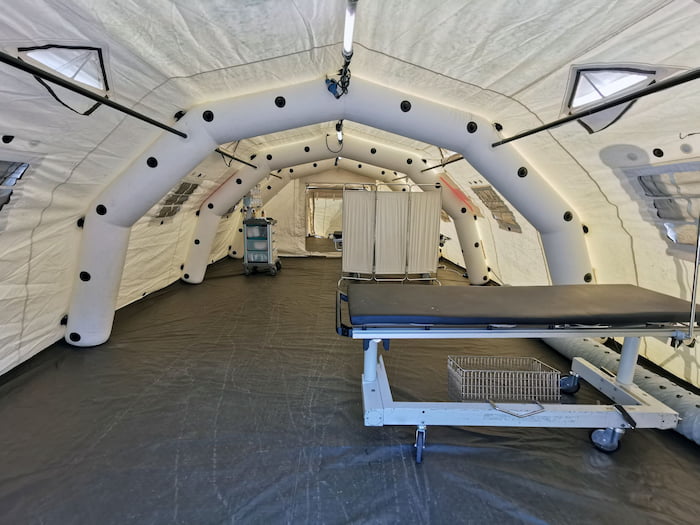Global warming and other environmental issues have recently exposed us to more frequent, violent, and highly damaging calamities.
The global Emergency Events Database (EM-DAT) recorded 432 disastrous events in 2021, a relatively higher figure than the 357 average between 2001 to 2020.
The first four months of this year were neither easy nor smooth sailing. There were violent cyclones in New Zealand, flooding in Brazil, tornadoes in the United States, and the Turkey-Syria earthquake, which claimed the lives of more than 50,000 people.
Major disasters put a heavy strain on resources, and most governments (especially in developing countries) are often unable to meet the compounding needs of their citizens. In such cases, military field hospitals are usually built to supplement, if not temporarily replace, struggling or non-functioning healthcare facilities.
Since natural disasters are inevitable, the government and private sectors must work together to adopt a proactive and flexible approach to calamity response. Field hospitals are the latest in that long line of solutions and may play a bigger role in the future.
Here’s how to prepare and set up mobile field hospitals for calamities.
1- Coordination Is Key
Host countries often need help to address large-scale disasters and would welcome any assistance. However, before setting up a mobile field hospital, it’s imperative for aid organizations, whether government or private-sector-led, to coordinate with authorities and other groups on the ground.
Organizations must likewise conduct a rapid assessment to determine the best location and offer other assistance modes to vulnerable, unserved, or underserved populations. Doing so ensures equitable healthcare access even during calamities. Studying the situation and acting according to needs allows seamless operations between and among humanitarian groups, benefitting the disaster victims.
2- Setting Up The Mobile Field Hospital
Mobile hospitals range from a few small tents to huge portable medical units within or near a disaster zone. The site must be safe from the next calamity or attack, as aid groups must put a premium on the safety and lives of their staff.
Here are some key considerations:
Choosing a location
While it’s important to be at the heart of the calamity area, you must consider factors like logistics, access to resources, security, and safety. Striking a good balance between these elements is necessary for deciding where to set up your operations.
Quick deployment
Ideally, the facility must be built within a day or two following an internal rapid assessment activity—where the medical team can identify priority healthcare needs. Field hospitals are classified based on their proximity, the number of medical staff, available medical equipment and supplies, and the services they provide.
Basic facilities required
At the minimum, mobile field hospitals must have access to a water source. Power supplies, like generators, vehicles, and telecommunications equipment, are likewise necessary. So are local volunteers, who may be medical professionals or individuals with a non-medical background.
Keeping these considerations in mind ensures the safe, efficient setup of field hospitals in crisis situations.

3- Building Your Team
The success of any healthcare facility largely depends on the medical team. Field hospitals are no exception.
Mobile field hospital staff should be skilled and experienced enough to work in high-pressure and challenging situations. Disaster victims undergo severe mental and physical trauma, and healthcare workers need special training to handle and interact with them efficiently.
Nurses must be skilled at triaging or identifying patients with urgent healthcare needs. In addition, employing reliable local staff may be necessary to work around communication and cultural gaps.
4- Equipping The Field Hospital
In most cases, field hospitals become the first point of contact for the sick and injured. Basic medical and pharmaceutical items must be available, including devices for taking and monitoring vital signs.
Equipment needs will depend on the procedures your facility is authorized to perform, including pain and wound management, minor or major surgeries, etc.
Regardless of the types of health care services to be performed, field hospitals must include a shelter for the staff and at least one each for patients’ isolation, waiting, and recovery areas. Such spaces ensure that patients don’t get worse while waiting for their turn or that they can recuperate from injuries and trauma as soon as possible.
5- Ensure Mobility, Safety, And Communication
Proper access to logistics and communication are at the front and center of every mobile field hospital operation.
Such a facility must have easy and swift access to supplies, personnel, and patients to ensure smooth operations. Any obstacle to mobility can hamper their operations and deprive patients of life-saving services.
Similarly, with communication, the mobile field team can perform basic operations and arrange supply pick-ups, patient transfers, or medical evacuations. These are priority factors when choosing the right field hospital location.
Personnel safety is also paramount in any disaster response. Besides ensuring that the field hospital is located outside hazardous areas, deploying security personnel nearby is best, especially in conflict zones.
The New Nexus Of Crisis Care
Disaster response must be quick yet tailored based on the priority needs of the affected population. The practices discussed above can be implemented to improve responses during emergencies without compromising the response team’s safety and security.
As such, mobile field hospitals must be versatile to meet the rapid changes in the field. A highly flexible yet scalable response can easily be set up and expanded as you improve your hospital operations internally, addressing the medical needs of disaster victims more efficiently.
Read Also
- Understanding the Importance of Routine Health Screenings for SeniorsDid you know that the global routine health screening market is expected to reach $105.93 billion by 2033? This highlights the rising focus on preventive healthcare. As we age, our bodies go through many changes. Staying proactive about health becomes more important with time. Routine health screenings for seniors play a vital role in maintaining… Read more: Understanding the Importance of Routine Health Screenings for Seniors
- Why Modern Retirement Facilities Are Vital for Chronic Disease CareToday’s retirement feels different from the past. Modern communities are bright, active, and full of life. They give seniors comfort while also providing the care needed for health and safety. For those living with long-term conditions like diabetes or heart disease, these places bring both support and peace of mind. Here, life doesn’t slow down-it… Read more: Why Modern Retirement Facilities Are Vital for Chronic Disease Care
- Understanding Breast Cancer Risks and Signs in Older MenMany people associate breast cancer with women. But did you know that breast cancer risk in older men is a significant health concern? Although it is rare, men can develop this disease, especially in later years. Understanding the risks, symptoms, and necessary preventive actions can lead to earlier detection and treatment, ultimately improving survival rates.… Read more: Understanding Breast Cancer Risks and Signs in Older Men
- How to Choose the Perfect Eyewear for Your Face Shape and StyleEyewear has evolved far beyond a simple vision aid—today, it’s a bold statement of personality, professionalism, and fashion sense. Whether you’re selecting your first pair or updating your look, the right frames can enhance your features, elevate your confidence, and even influence first impressions. But with endless options available, how do you find the perfect… Read more: How to Choose the Perfect Eyewear for Your Face Shape and Style
- Designing Engaging Slot Themes: Art Meets Math1. Introduction — Why Themes Rule the Reels Every great slot starts with a story. Whether it’s ancient Egypt, futuristic cyber cities, or Norse gods swinging thunderbolts, themes breathe life into cold math. Players don’t just chase wins — they chase worlds. In 2024, 77% of new slot titles released by major studios like Pragmatic Play and… Read more: Designing Engaging Slot Themes: Art Meets Math
- How to Choose the Right Senior Living Community for Your NeedsHow do you know which senior living community fits your needs best? Choosing the right place can feel tricky with so many options, from independent living to assisted care. It’s important to think about daily routines, medical support, social activities, and the kind of environment that feels safe and welcoming. You also want a place… Read more: How to Choose the Right Senior Living Community for Your Needs







